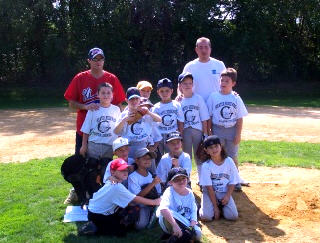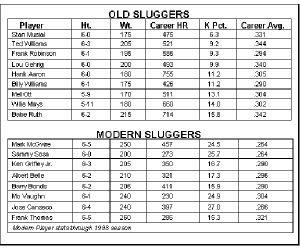News and Announcements


How to Raise Your Batting Average 100 Points
Posted by Patrick Piteo at Nov 7, 2002 4:00PM PST
( 0 Comments
)
As a former college coach who now runs a baseball camp year round, I spend a lot of time talking and teaching the skill of hitting a baseball. Too many times players and coaches are too concerned with the mechanics of the swing and forget about the mental side of hitting. We can spend hours going over swing mechanics and even players with beautiful swings may still only wind up batting .250. I'm amazed whenever I ask a player, "What's your favorite pitch?" I get all types of answers from "curveball on the outside corner to fastball low and away" but most of the times, it's a question that kids of all ages have no answer for. Most players answer the question with, "I like strikes." The plate is 18 inches wide and the strike zone goes from the 'letters' to the 'knees' now that's a pretty big area for which a strike can be called. It's important for players to learn and understand which pitches they hit the best. After all, if you don't know what pitch you're looking for, you will most likely wind up swinging at bad pitches and not waiting for 'your pitch'. Over the course of a season, the difference between batting .250 and .300 is only one more hit a week! That could be a seeing eye basehit or a bloop over the first baseman's head! More importantly and perhaps even easier is making one or two less outs a week by not swinging at bad pitches. I see plenty of baseball games and I'm amazed at how many players swing at a first pitch curveball. Most of those players wind up making an out. I'll ask the player, "Why did you swing at that pitch? Were you looking for a curveball?" 99% of the players I ask that question to respond with a no. When I as why they swung, they said because the pitch was a strike. Once you explain to them that you shouldn't swing at a pitch that you aren't looking for with less than 2 strikes, you can see the light bulb go on over their heads! Ask yourself how many times you've swung at a bad pitch and made on out and you'll be surprised at how many times you can recall doing that. Most kids are afraid to hit with one or two strikes on them. I tell players it's better to be 0-1 in the count than 0-1 in the game. If you take a pitch that you aren't looking for, the next pitch you see may be 'your pitch' and that increases your chances of getting a hit or at least getting a good swing. It's also important to get yourself ready for each pitch. Too many kids swing defensively. They wait too long and swing tentatively. You must assume that each pitch you are about to get is 'your pitch'. If you assume it's your pitch you'll be ready for it. It's much easier to have the mindset of yes - yes - yes - swing! If instead you think in the batters box, maybe - maybe - maybe - yes - swing, then you aren't being aggressive. It's much better to think yes - yes - yes - no, that's not my pitch than to say maybe - maybe - yes that's my pitch. At the Spartans Baseball Camp we spend a lot of time on swing mechanics with players and an equal amount of time on helping kids learn what their favorite pitch is and then being disciplined and aggressive so when they see their favorite pitch they get a good aggressive swing at it. About the author: Jim Romeo was the former Head Baseball Coach at St. Thomas Aquinas College, Sparkill, NY. At 25 he was the youngest Head Baseball Coach of any 4-year varsity college program in the country. He was also the youngest coach to win the CACC Coach of the Year Award as well as Louisville Slugger Coach of the Year award. He recruited and coached 12 All Conference Players, 3 All Region and 3 All American Players in his 3 years at St. Thomas Aquinas College. He also had 4 players sign professional contracts during that time. Before resigning to run the Spartans Baseball Camp on a full time basis, he led the St. Thomas Aquinas Spartans to their best year going 25-11 and winning the CACC Championship and finishing 3 games shy of the NAIA College World Series. He is the Director of the Spartans Baseball & Softball Camp which is held in Bergen County, NJ and Rockland County, NY. The Spartans Baseball & Softball camp just celebrated their 10 Year Anniversary this past July. They off year round camps and clinics as well as private instruction in all aspects of baseball & softball. You can visit their website to learn more at www.baseballcamp.com or call (201)568-7802. Visit BeABetterHitter.Com Baseball


Lost Secrets of Hitting - By Coach Rob Ellis
Posted by Patrick Piteo at Nov 7, 2002 4:00PM PST
( 0 Comments
)


1.) Think and assess the situation BEFORE entering the Batter’s box. 2.) Relax and deep breaths (oxygen to the brain and muscles) as you dig in. 3.) Never speak or exchange words with the catcher. Dismiss him in your mind. 4.) Soft focus on the pitcher’s hat until ball appears in release window… switch! 5.) Your approach should be “YES, YES, YES” on every pitch, be prepared to hit every pitch! Let your eyes and body tell you “NO”. 6.) Treat every first pitch like a 2-0. Expect fastball down the middle and attack it! 7.) Step out after each pitch… deep breaths… think “accurate barrel”… back to soft focus. 8.) No matter the count.. ALWAYS expect fastball. ADJUST to off-speed. 9.) Move up in the box in a “bunt” situation. Back in the box for “hit and run”. 10.) ALWAYS BELIEVE YOU CAN! !
Greg Modica Signs Contract With The Padres
Posted by Patrick Piteo at Nov 5, 2002 4:00PM PST
( 0 Comments
)
Former Ridgewood, Glendale, Middle Village, Maspeth Little League and King baseball fire-thrower Greg Modica has signed a Rookie A contract with the National League San Diego Padres. Click The Link Above For The Full Story. In The Coming Weeks We Will Add More RGMVM League Alumni... So Check Back Often !!
